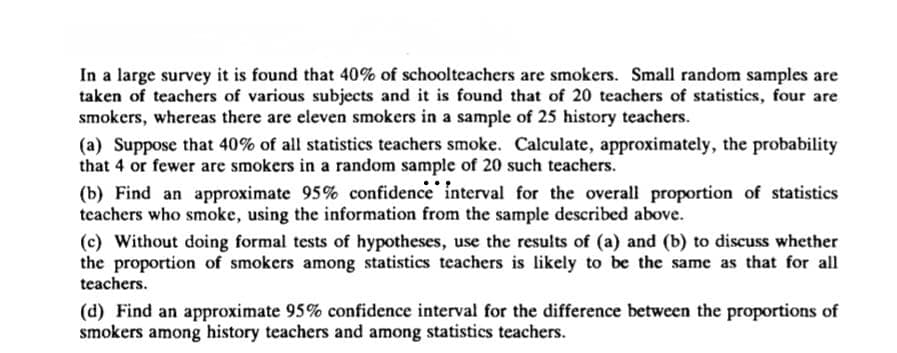In a large survey it is found that 40% of schoolteachers are smokers. Small random samples are taken of teachers of various subjects and it is found that of 20 teachers of statistics, four are smokers, whereas there are eleven smokers in a sample of 25 history teachers. (a) Suppose that 40% of all statistics teachers smoke. Calculate, approximately, the probability that 4 or fewer are smokers in a random sample of 20 such teachers. (b) Find an approximate 95% confidence interval for the overall proportion of statistics teachers who smoke, using the information from the sample described above. (c) Without doing formal tests of hypotheses, use the results of (a) and (b) to discuss whether the proportion of smokers among statistics teachers is likely to be the same as that for all teachers. (d) Find an approximate 95% confidence interval for the difference between the proportions of smokers among history teachers and among statistics teachers.
In a large survey it is found that 40% of schoolteachers are smokers. Small random samples are taken of teachers of various subjects and it is found that of 20 teachers of statistics, four are smokers, whereas there are eleven smokers in a sample of 25 history teachers. (a) Suppose that 40% of all statistics teachers smoke. Calculate, approximately, the probability that 4 or fewer are smokers in a random sample of 20 such teachers. (b) Find an approximate 95% confidence interval for the overall proportion of statistics teachers who smoke, using the information from the sample described above. (c) Without doing formal tests of hypotheses, use the results of (a) and (b) to discuss whether the proportion of smokers among statistics teachers is likely to be the same as that for all teachers. (d) Find an approximate 95% confidence interval for the difference between the proportions of smokers among history teachers and among statistics teachers.
Holt Mcdougal Larson Pre-algebra: Student Edition 2012
1st Edition
ISBN:9780547587776
Author:HOLT MCDOUGAL
Publisher:HOLT MCDOUGAL
Chapter11: Data Analysis And Probability
Section11.8: Probabilities Of Disjoint And Overlapping Events
Problem 2C
Related questions
Question
100%
Practice Pack

Transcribed Image Text:In a large survey it is found that 40% of schoolteachers are smokers. Small random samples are
taken of teachers of various subjects and it is found that of 20 teachers of statistics, four are
smokers, whereas there are eleven smokers in a sample of 25 history teachers.
(a) Suppose that 40% of all statistics teachers smoke. Calculate, approximately, the probability
that 4 or fewer are smokers in a random sample of 20 such teachers.
(b) Find an approximate 95% confidence interval for the overall proportion of statistics
teachers who smoke, using the information from the sample described above.
(c) Without doing formal tests of hypotheses, use the results of (a) and (b) to discuss whether
the proportion of smokers among statistics teachers is likely to be the same as that for all
teachers.
(d) Find an approximate 95% confidence interval for the difference between the proportions of
smokers among history teachers and among statistics teachers.
Expert Solution
This question has been solved!
Explore an expertly crafted, step-by-step solution for a thorough understanding of key concepts.
Includes step-by-step video
Learn your way
Includes step-by-step video
Step by step
Solved in 4 steps with 4 images

Recommended textbooks for you

Holt Mcdougal Larson Pre-algebra: Student Edition…
Algebra
ISBN:
9780547587776
Author:
HOLT MCDOUGAL
Publisher:
HOLT MCDOUGAL

College Algebra
Algebra
ISBN:
9781305115545
Author:
James Stewart, Lothar Redlin, Saleem Watson
Publisher:
Cengage Learning

Algebra & Trigonometry with Analytic Geometry
Algebra
ISBN:
9781133382119
Author:
Swokowski
Publisher:
Cengage

Holt Mcdougal Larson Pre-algebra: Student Edition…
Algebra
ISBN:
9780547587776
Author:
HOLT MCDOUGAL
Publisher:
HOLT MCDOUGAL

College Algebra
Algebra
ISBN:
9781305115545
Author:
James Stewart, Lothar Redlin, Saleem Watson
Publisher:
Cengage Learning

Algebra & Trigonometry with Analytic Geometry
Algebra
ISBN:
9781133382119
Author:
Swokowski
Publisher:
Cengage


College Algebra (MindTap Course List)
Algebra
ISBN:
9781305652231
Author:
R. David Gustafson, Jeff Hughes
Publisher:
Cengage Learning